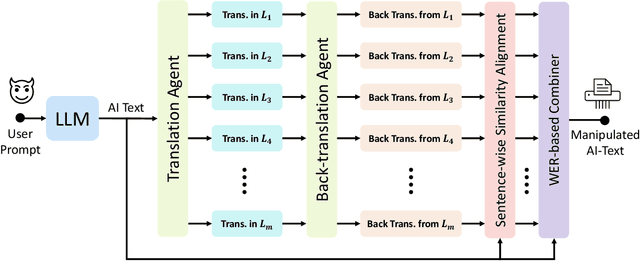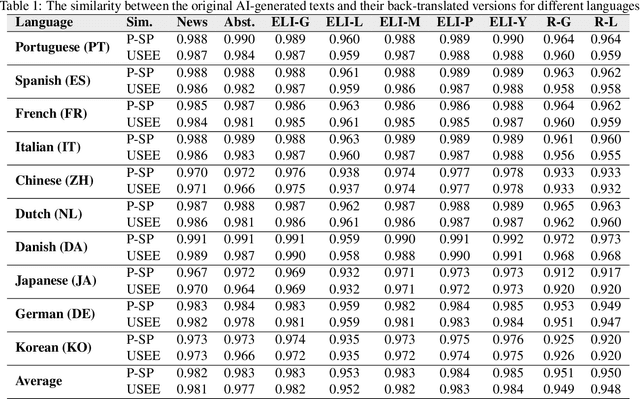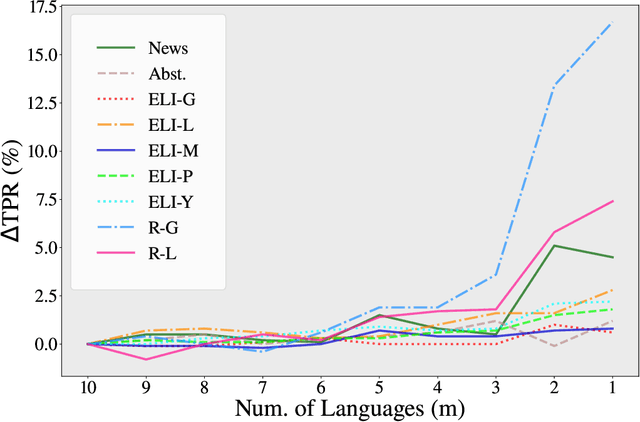Sylvain Flamant
ESPERANTO: Evaluating Synthesized Phrases to Enhance Robustness in AI Detection for Text Origination
Sep 22, 2024



Abstract:While large language models (LLMs) exhibit significant utility across various domains, they simultaneously are susceptible to exploitation for unethical purposes, including academic misconduct and dissemination of misinformation. Consequently, AI-generated text detection systems have emerged as a countermeasure. However, these detection mechanisms demonstrate vulnerability to evasion techniques and lack robustness against textual manipulations. This paper introduces back-translation as a novel technique for evading detection, underscoring the need to enhance the robustness of current detection systems. The proposed method involves translating AI-generated text through multiple languages before back-translating to English. We present a model that combines these back-translated texts to produce a manipulated version of the original AI-generated text. Our findings demonstrate that the manipulated text retains the original semantics while significantly reducing the true positive rate (TPR) of existing detection methods. We evaluate this technique on nine AI detectors, including six open-source and three proprietary systems, revealing their susceptibility to back-translation manipulation. In response to the identified shortcomings of existing AI text detectors, we present a countermeasure to improve the robustness against this form of manipulation. Our results indicate that the TPR of the proposed method declines by only 1.85% after back-translation manipulation. Furthermore, we build a large dataset of 720k texts using eight different LLMs. Our dataset contains both human-authored and LLM-generated texts in various domains and writing styles to assess the performance of our method and existing detectors. This dataset is publicly shared for the benefit of the research community.
SteloCoder: a Decoder-Only LLM for Multi-Language to Python Code Translation
Oct 24, 2023



Abstract:With the recent focus on Large Language Models (LLMs), both StarCoder (Li et al., 2023) and Code Llama (Rozi\`ere et al., 2023) have demonstrated remarkable performance in code generation. However, there is still a need for improvement in code translation functionality with efficient training techniques. In response to this, we introduce SteloCoder, a decoder-only StarCoder-based LLM designed specifically for multi-programming language-to-Python code translation. In particular, SteloCoder achieves C++, C#, JavaScript, Java, or PHP-to-Python code translation without specifying the input programming language. We modified StarCoder model architecture by incorporating a Mixture-of-Experts (MoE) technique featuring five experts and a gating network for multi-task handling. Experts are obtained by StarCoder fine-tuning. Specifically, we use a Low-Rank Adaptive Method (LoRA) technique, limiting each expert size as only 0.06% of number of StarCoder's parameters. At the same time, to enhance training efficiency in terms of time, we adopt curriculum learning strategy and use self-instruct data for efficient fine-tuning. As a result, each expert takes only 6 hours to train on one single 80Gb A100 HBM. With experiments on XLCoST datasets, SteloCoder achieves an average of 73.76 CodeBLEU score in multi-programming language-to-Python translation, surpassing the top performance from the leaderboard by at least 3.5. This accomplishment is attributed to only 45M extra parameters with StarCoder as the backbone and 32 hours of valid training on one 80GB A100 HBM. The source code is release here: https://github.com/sade-adrien/SteloCoder.
 Add to Chrome
Add to Chrome Add to Firefox
Add to Firefox Add to Edge
Add to Edge